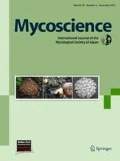Abstract
In an attempt to suppress the propagation of citrus greening disease in Indonesia, we explored pathogens ofDiaphorina citri which vectors the disease. At two orange orchards, manyD. citri adults were found to be dead and covered with fungal mycelia. Two fungi,Paecilomyces fumosoroseus andHirsutella citriformis, were consistently isolated from the infected insects. Molecular phylogeny of their 18S rDNA sequences showed that they belong to the ascomycetous clade of the Clavicipitales/Hypocreales, which embraces many entomopathogenic fungi. When healthy adults ofD. citri were inoculated with conidia of theP. fumosoroseus, the insects died within 6 d.
Literature cited
Aoki, J. 1989. A key for insect pathogenic fungi. Zenkoku Noson Kyoiku Kyokai, Tokyo (In Japanese.)
Baker, R. R. and Dunn, P. E. 1990. New directions in biological control. Alan R. Liss, New York.
Burges, H. D. 1981. Microbial control of pests and plant diseases 1970–1980. Academic Press, New York.
Capoor, S. P., Rao, D. G. and Viswanath, S. M. 1967.Diaphorina citri Kuway, a vector of the greening disease of citrus in India. Indian J. Agric. Sci.37: 572–576.
da Graçia, J. V. 1991. Citrus greening disease. Ann. Rev. Phytopathol.29: 109–136.
Felsenstein, J. 1985. Confidence limits on phylogenies: an approach using the bootstrap. Evolution39: 783–791.
Jagoueix, S., Bové, J. M. and Garnier, M. 1994. The phloemlimited bacterium of greening disease of citrus is a member of the α subdivision of theProteobacteria. Int. J. Syst. Bacteriol.44: 379–386.
Kimura, M. 1980. A simple method for estimating evolutionary rate of base substitutions through comparative studies of nucleotide sequences. J. Mol. Evol.16: 111–120.
McClean, A. P. D. and Oberholzer, P. C. J. 1965. Citrus psylla, a vector of the greening disease of sweet orange. S. Afr. J. Agric. Sci.8: 297–298.
Saitou, N. and Nei, M. 1987. The neighbor-joining method: a new method for reconstructing phylogenetic trees. Mol. Biol. Evol.4: 406–425.
Samson, R. A. 1974.Paecilomyces and some allied Hyphomycates. Stud. Mycol.6: 1–119.
Schwartz, R. E., McClean, A. P. D. and Catling, H. D. 1970. The spread of citrus greening disease by the citrus psylla in South Africa: Phytophylactica2: 59–60.
Swofford, D. L. 1993. PAUP: phylogenetic analysis using parsimony version 3.1.1.
Tanada, Y. and Kaya, H. K. 1993. Insect pathology. Academic Press, San Diego
Thompson, J. D., Higgins, D. G. and Gibson, T. J. 1994. CLUSTAL W: improving the sensitivity of progressive multiple sequence alignment through sequence weighting, positions-specific gap penalties and weight matrix choice. Nucleic Acids Res.22: 4673–4680.
Tirtawidjaja, S. 1980. Citrus virus research in Indonesia. In “Proceedings of 8th international organization of citrus virologists (IOCV)” (E. C. Calavan, S. M. Garnsey, and L. W. Timmer, Ed.), pp. 129–132. IOCV. Riverside, CA.
Author information
Authors and Affiliations
Corresponding author
About this article
Cite this article
Subandiyah, S., Nikoh, N., Sato, H. et al. Isolation and characterization of two entomopathogenic fungi attackingDiaphorina citri (Homoptera, Psylloidea) in Indonesia. Mycoscience 41, 509–513 (2000). https://doi.org/10.1007/BF02461672
Accepted:
Issue Date:
DOI: https://doi.org/10.1007/BF02461672

